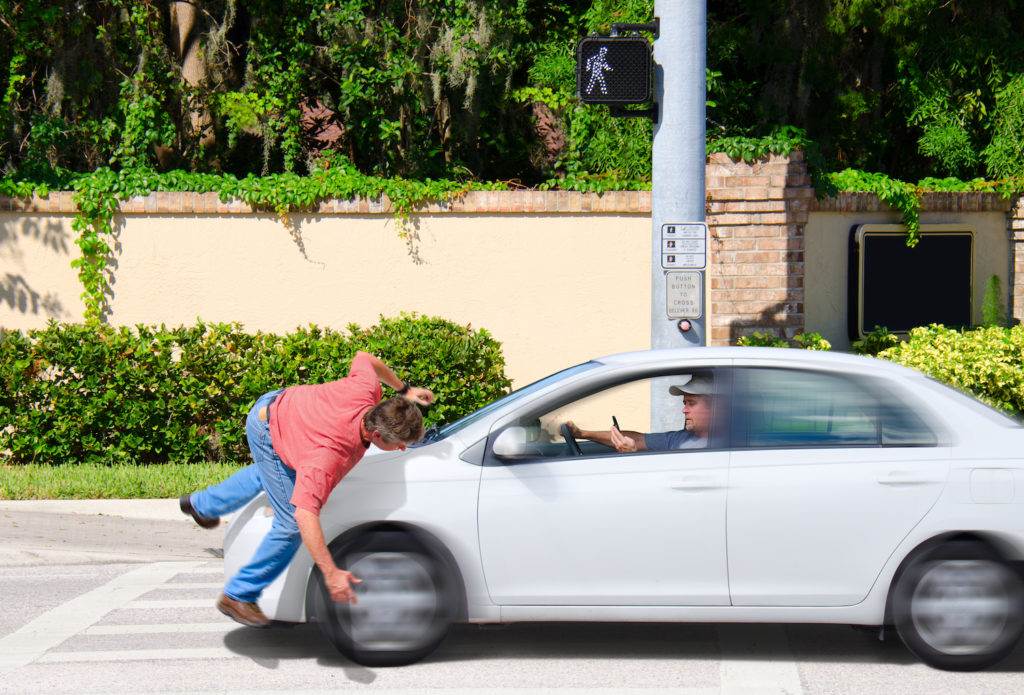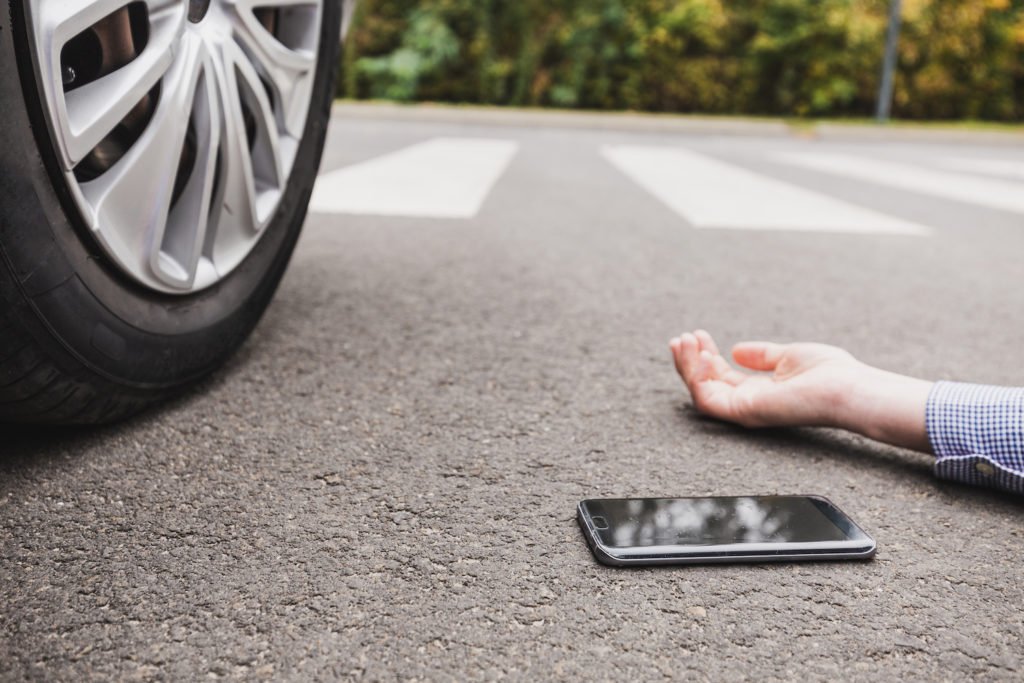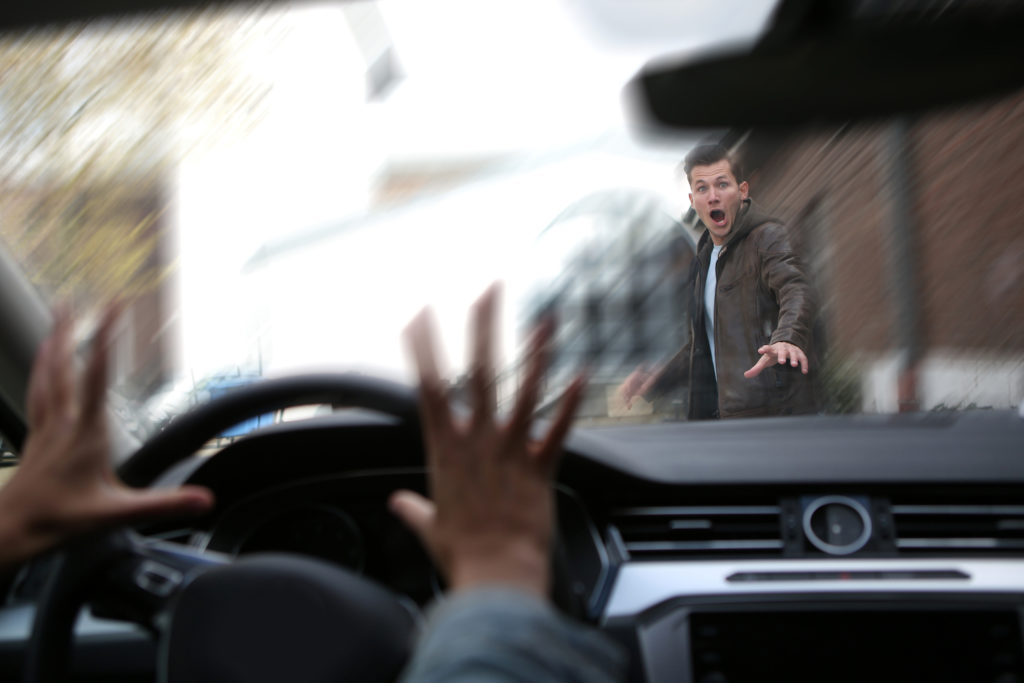
Pedestrians hit by a car in California can sue the driver for negligence to cover their medical bills, lost wages, and pain and suffering. If the pedestrian dies, their family can sue the driver for wrongful death to recover funeral expenses and loss of support.
Drivers are usually to blame in pedestrian knockdown accidents, but pedestrians do not always have right-of-way. If for example a car hits you while you are jaywalking, you can still sue the driver for failing to swerve in time – but the court will reduce your monetary damages in proportion to your degree of fault.
Definition of Pedestrian
In California, the term pedestrian comprises not only walkers but also:
- roller-skaters and roller-bladers,
- skateboarders and hoverboarders,
- people in wheelchairs, and
- tricycle or quadricycle riders.
Bicyclists are not considered pedestrians.1
Accident Statistics
California has the most pedestrian fatalities of any state. In 2022, 1,100 pedestrians died in traffic accidents in California. The pedestrian fatality rate was 2.82 for every 100,000 people.
2021 saw 1,108 pedestrian fatalities in California, a 9.3% increase from the year prior. In 2018, more than 14,000 pedestrians were injured by vehicles. The number of pedestrian fatalities between 2009 and 2018 was almost 7,500.
Approximately 45% of pedestrian accidents resulting in death or serious injury happen between 6pm and midnight. Therefore, pedestrians are advised to wear light-colored or reflective clothing if they are walking at night.2

Pedestrians have the right-of-way at marked crosswalks and presumed crosswalks at intersections.
Do pedestrians always have the right-of-way in California?
No. Pedestrians in California have the right-of-way only at marked and unmarked crosswalks at intersections (unless a traffic light or officer signals otherwise).3
That being said, vehicles approaching jaywalkers must “exercise due care” by doing everything possible – such as yielding right of way – to avoid hitting them.4 California’s “basic speed” law requires drivers to slow down if circumstances call for it despite what the posted speed limit is.5
Note that visually-impaired pedestrians signal with their cane whether they wish to enter a crosswalk. Pulling the cane back means that they are staying put and the driver can proceed.6
Suing Drivers for Pedestrian Knockdowns
If you are hit in California by a car (or by a motorcycle, bicycle or e-scooter), you can sue the driver for negligence. Most lawsuits settle, but should your case reach trial, you would have to prove that:
- The driver owed you a duty of care (by driving safely);
- The driver breached that duty of care (by violating a traffic law); and
- The driver’s negligence was a substantial factor in causing your injury.7
In order to prove the driver was at fault for the accident, our personal injury attorneys rely on such evidence as:
- Surveillance video
- Eyewitness accounts
- GPS data
- Phone data
- Accident reconstruction expert testimony
- Medical expert testimony
What if I was partly to blame?
California is a “pure comparative fault” state, which means you can still recover damages in a personal injury lawsuit if you were partially to blame. However, the amount of damages you can recover gets reduced by your percentage of fault.8
Example: You are intoxicated and jaywalking when a driver hits you, causing $100,000 in damages. The court finds that you were 50% at fault for the jaywalking and intoxication, and the driver was 50% at fault for texting while driving. Therefore, the court would award you $50,000 (50% of your total damages).
When the Victims are Schoolchildren
Some of the most devastating pedestrian accidents involve drivers hitting schoolchildren. This typically happens when drivers fail to:
- slow down to 25 mph within 500 feet of a school while children are outside, or
- follow the school crossing guard’s directions, or
- stop when a school bus flashes its yellow or red lights, no matter which direction they are coming from.9
Even if no one gets injured, drivers who fail to stop when a school bus is flashing red lights risk getting a traffic infraction ticket.10 If schoolchildren get hit by a car, their parents can bring a negligence lawsuit not only against the driver but also against the school for failing to keep them safe.
Other Pedestrian Accidents
Not all pedestrian accidents involve vehicles. For instance, many pedestrians get hurt from tripping and falling over uneven pavement, a slippery or icy surface, debris, or a manhole.
If this happens to you, you may be able to bring a premises liability lawsuit against the property owner or operator. In order to prevail in a lawsuit, you would have to prove:
- The defendant was in control of the property where you tripped,
- The defendant was negligent by failing to keep the property free of reasonably foreseeable hazards, and
- You were injured due to the defendant’s negligence.11

California’s comparative fault laws permit you to recover damages even if you were partly to blame.
Can I go through insurance?
Yes. In fact, most pedestrian accident cases settle with an insurance settlement and no lawsuit being filed.
The driver who hit you must file a claim with their insurance company. California law requires each driver to carry liability insurance of at least:
- $15,000 for injury/death to one person,
- $30,000 for injury/death to more than one person, and
- $5,000 for damage to property.12
If your damages exceed what the driver’s insurance covers, you can sue for the difference.
What about wrongful death lawsuits?
When a pedestrian dies in an accident, surviving family members who can file a wrongful death lawsuit include:
- A spouse;
- A domestic partner;
- Children;
- Grandchildren (if the deceased victim’s children are deceased); or
- Anyone else who would be entitled to the property of the decedent by California intestate succession laws.13
Note that a “survival” cause of action is different from a wrongful death lawsuit. It is brought on behalf of the victim’s estate and seeks damages for the losses the deceased victim suffered from the wrongful act.14
Five steps to take if you are injured in a pedestrian accident
- Seek medical attention, even if you feel fine. Sometimes injuries such as soft tissue damage take time to manifest. Also be sure to save your medical records and bills.
- Take photos and videos of the scene and of your injuries, and take down the contact information of any eyewitnesses. Also write down everything you remember in detail, including the weather, road conditions, and what you are wearing. Plus get the following information from the driver(s) who hit you: Name, contact info, driver’s license number, insurance information, and the license plate number.
- Contact the police, who will write up a police report that will serve as valuable evidence in a lawsuit.
- Do NOT admit fault or say that you are uninjured. You could be wrong, and these admissions could hinder you getting a settlement.
- Contact a personal injury attorney as soon as possible. Once you have an attorney, they will deal directly with the driver’s insurance company.

Pedestrians do not always have right-of-way.
Additional Resources
For more information, our Los Angeles pedestrian accident lawyers suggest you refer to the following:
- U.S. pedestrian deaths reach a 40-year high – News article by National Public Radio (NPR).
- Pedestrian Safety – Statistics by the Centers for Disease Control and Prevention (CDC).
- Pedestrian Safety – Statistics and tips by the National Highway Transportation Safety Administration (NHTSA).
- Traffic Safety Facts: Pedestrians – Analysis of 2021 data by NHTSA.
- Pedestrian Traffic Fatalities by State: 2022 Preliminary Data – Statistics by the Governors Highway Safety Association.
Legal References:
- California Vehicle Code 467 VC.
- Pedestrian Safety, California Office of Traffic Safety. Pedestrian and Bicycle Safety, California Office of Traffic Safety. Marc Sternfield, California saw a 10% increase in pedestrian traffic deaths over 3 years, KTLA-5 (Apr 28, 2023). Stephanie Sierra and Lindsey Feingold, CA roads are 3rd deadliest in US for pedestrians, data shows. Here’s how Bay Area counties fare, ABC-7 (January 25, 2024). SafeTREC, 2020, Berkeley, California Office of Traffic Safety. Pedestrian Traffic Fatalities by State: 2022 Preliminary Data, Governor’s Highway Safety Association.
- California Vehicle Code 21950 VC (“The driver of a vehicle shall yield the right-of-way to a pedestrian crossing the roadway within any marked crosswalk or within any unmarked crosswalk at an intersection.”).
- Same.
- California Vehicle Code 22350 VC.
- California Driver’s Handbook.
- CACI 400.
- CACI 405. CACI 406.
- California Vehicle Code 22352 VC.
- California Vehicle Code 22454 VC.
- CACI 1000.
- Insurance Requirements, California DMV.
- California Code of Civil Procedure 377.60.
- Code of Civil Procedure 377.30.
